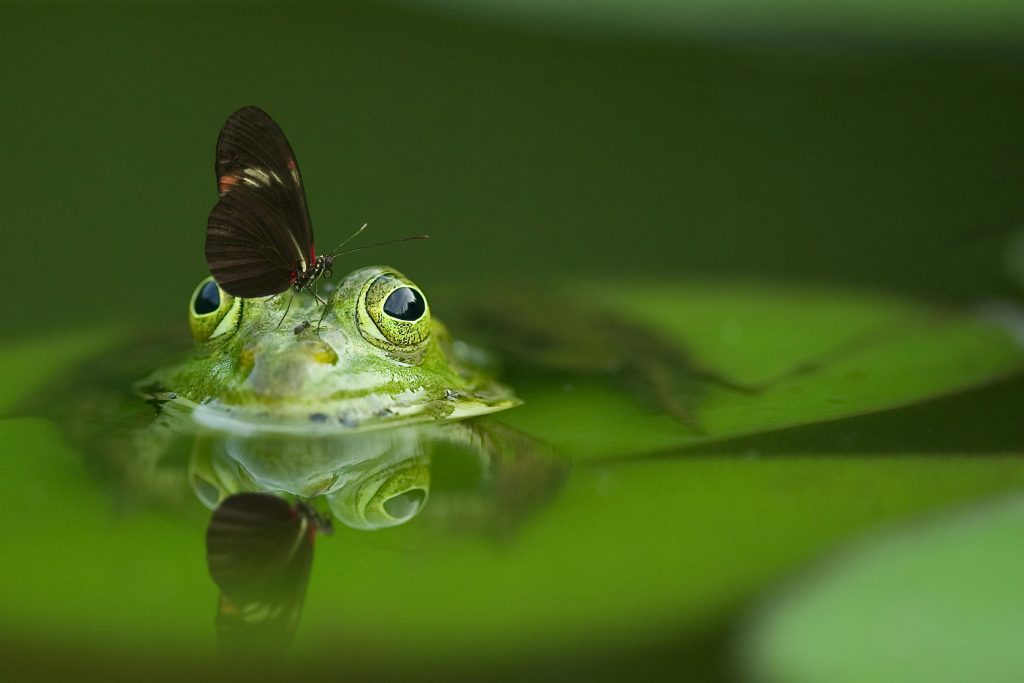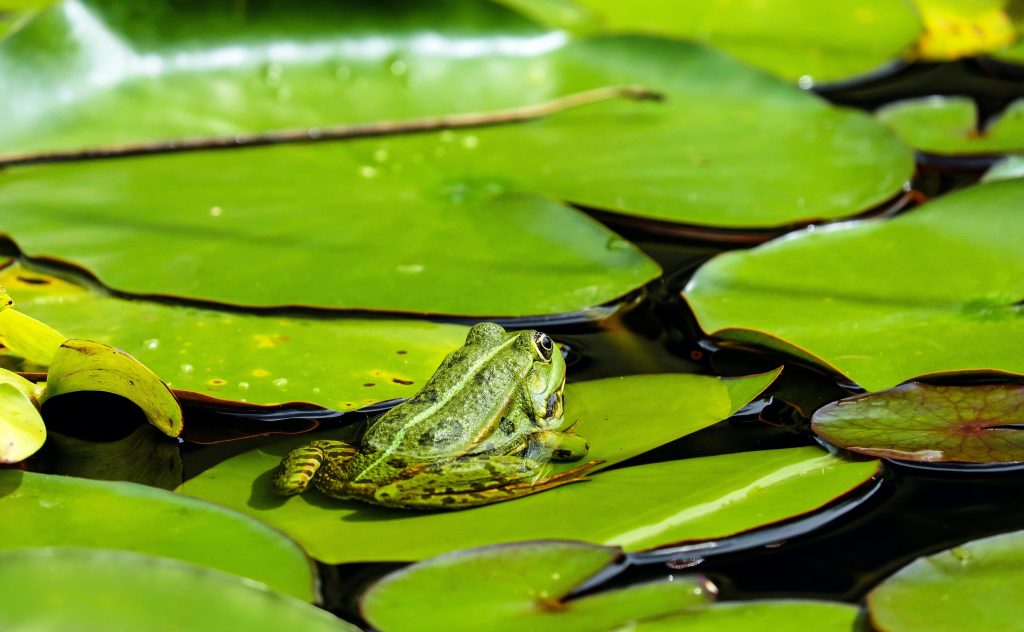Your cart is currently empty!
Female Frogs Fake Their Death to Avoid Mating With Males They Don’t Like

When danger strikes in the animal kingdom, the options are often fight, flee… or, in some cases, play dead. Opossums collapse into limp stillness when a predator closes in. Certain dragonflies plummet to the ground, feigning lifelessness to avoid a mate they’ve already accepted once. And now, scientists have discovered a surprising new member of this dramatic club: the female European common frog.
Each spring, these amphibians gather in their hundreds around still ponds, racing to reproduce in a frantic two-week sprint. For males, it’s a numbers game the more mates, the better. For females, it’s a gauntlet. Several males can pile onto the same female in what biologists call a “mating ball,” a suffocating, churning knot of bodies that can end in injury or death. In such chaos, subtlety and polite refusals don’t work. Survival demands creativity.
Researchers observing these frogs in controlled experiments noticed something extraordinary: when all else failed, some females simply went limp, stiffened their limbs, and drifted as if lifeless. The males, confused, often let go. The frog would “revive” moments later and swim away unharmed, unmated, and free.
It’s a performance as theatrical as it is effective, and it challenges the old idea that female frogs are passive players in the breeding season frenzy. Instead, these small, unassuming creatures have evolved a set of tactics including this remarkable death-feigning act to reclaim a measure of control in a high-stakes contest for survival.
The High-Stakes World of Explosive Breeding
For the European common frog (Rana temporaria), the mating season is not a leisurely courtship; it’s a tightly compressed, high-pressure event known as “explosive breeding.” Taking place in early spring, often just as ice retreats from ponds, the entire reproductive cycle can be squeezed into as little as a few days and rarely longer than two weeks. In that short window, hundreds of frogs converge on the same waterbody in a teeming, restless mass.
Males far outnumber females, setting the stage for intense competition. In the rush to mate before the season ends, selectivity gives way to urgency; males will latch onto almost any moving body in the water, sometimes even other males or different species. This indiscriminate approach often leads to “mating balls” chaotic tangles of multiple males gripping a single female. While the term might sound quaint, the reality can be deadly: the combined weight and pressure can prevent the female from surfacing for air, leading to exhaustion, injury, or drowning.
Historically, biologists assumed that females caught in this frenzy were largely helpless, forced to endure the process until the males disengaged. But the peril of the mating ball is more than an inconvenience; it’s a genuine survival threat. In such a condensed and dangerous breeding window, every decision, every movement, carries weight. This is the crucible in which the European common frog’s unexpected repertoire of defensive maneuvers evolved, allowing females to push back sometimes literally against overwhelming odds.
The Study Behind the Discovery

The revelation of these unexpected escape tactics came almost by accident. Ecologist Carolin Dittrich and herpetologist Mark-Oliver Rödel, from the Leibniz Institute for Evolution and Biodiversity Science in Germany, originally set out to answer a straightforward question: do male European common frogs prefer females of a particular body size? Since larger females generally produce more eggs, evolutionary theory might suggest a male bias toward bigger mates.
To test this, the researchers placed two females of different sizes into a water tank with a single male and observed their interactions for an hour. The expectation was to record mating choices and see if size influenced male behavior. Instead, the real story unfolded in the unplanned details.
While no size preference emerged, what did appear was a surprising catalogue of female resistance behaviors deliberate, repeated actions aimed at escaping a male’s grasp. These were not isolated flukes: across 54 observed instances of males clasping females, avoidance strategies appeared frequently and in distinct forms.
The data were striking:
- 83% of clasped females attempted body rotation, twisting against the male’s grip in what might both loosen his hold and force him into a position where he risks drowning.
- 48% emitted release calls, low-frequency vocalizations that mimic the “wrong target” signals males use when mistakenly grabbed by another male.
- 33% employed tonic immobility going rigid and motionless, simulating death until the male released them.
Smaller females, the team found, were more likely to use these tactics and had a higher success rate in breaking free. Notably, these behaviors had never been formally documented in this species before. The findings, later published in Royal Society Open Science, shifted the perception of female common frogs from passive participants to active, strategic players in the breeding season drama.
The Three Survival Tactics

When survival depends on slipping free from a determined suitor, female European common frogs have more than one move in their playbook. Researchers documented three distinct behaviors, each serving as a different line of defense against the chaos of explosive breeding.
1. Body Rotation – The Twist to Freedom
The most common tactic used by more than four out of five clasped females involved a deliberate rolling motion. A female would pivot along her own axis, forcing the male to shift his grip or lose it entirely. This movement could also maneuver the male into a position where he risks inhaling water, prompting him to release her to avoid drowning. In the crowded, oxygen-limited conditions of a mating ball, that risk can be a decisive motivator.
2. Release Calls – Mimicking the Male’s “Wrong Target” Signal
Nearly half of the females deployed an auditory ruse: a low, grunt-like call remarkably similar to the one males emit when mistakenly seized by another male. In the frenzied pond environment, this call essentially says, “Let go I’m not your mate.” By imitating this signal, females exploit a reflexive male behavior, often prompting an immediate release. The deception works because males have little time to assess their target; an auditory cue can override the instinct to cling.
3. Tonic Immobility Playing Dead
The rarest, but arguably most dramatic, response was tonic immobility. About one-third of clasped females went completely rigid, extending their limbs and becoming unresponsive a posture strikingly similar to rigor mortis. In some cases, this stillness lasted minutes, even as the male dragged the motionless female through the water. Eventually, the male would abandon her, allowing the “revived” frog to swim away once the danger had passed. While death-feigning is well documented in the context of predator evasion, its use as a mating-avoidance strategy is uncommon and, in amphibians, almost unknown.
Each of these tactics offers a unique route to freedom. Rotation and release calls actively disrupt the male’s grip or perception, while tonic immobility takes a passive yet high-risk approach. Used individually or in combination, they demonstrate that even in the most compressed and chaotic breeding seasons, female frogs are capable of strategic, context-dependent self-defense.
Why This Behavior Evolved

In the evolutionary contest between survival and reproduction, the stakes for female European common frogs are unusually high. The males’ strategy is simple: mate with as many females as possible during the short breeding window. For females, however, sheer quantity of encounters offers no advantage they reproduce only once per season, and the risk of injury or death from overcrowding can outweigh the benefits of mating at all.
This mismatch in reproductive priorities is a textbook example of sexual conflict a dynamic where the optimal strategy for one sex creates costs for the other. For males, grabbing first and assessing later is advantageous in a competitive pond teeming with rivals. For females, it’s a hazard. In the crush of a “mating ball,” the added weight and pressure can limit oxygen intake, and frantic movement can attract even more males to the scrum, amplifying the danger.
Under these conditions, elaborate courtship rituals or selective mate choice seen in many birds and mammals offer little protection. In fact, researchers found no evidence that females choose mates at all in this species. Even if they did, “clutch piracy” observed in previous studies shows that satellite males can fertilize eggs after the primary male departs, erasing any advantage gained from selectivity.
Instead, female frogs appear to have evolved avoidance behaviors as a direct survival mechanism. By rolling, calling, or feigning death, they increase their odds of escaping lethal entanglements without drawing more attention. Smaller females, in particular, benefit from these tactics, as their lighter bodies make it easier to slip away during a struggle.
Avoidance Behaviors Across the Animal Kingdom

While tonic immobility in a mating context may be rare among vertebrates, the idea of using deception or extreme tactics to escape unwanted advances isn’t unique to the European common frog. Across the animal kingdom, females and occasionally males have evolved remarkable strategies to evade persistent or dangerous suitors.
In the insect world, the moorland hawker dragonfly offers an almost uncanny parallel. Females of this species have been observed dropping suddenly from the air and lying motionless among vegetation when pursued by a male, effectively “playing dead” to avoid costly mating after they’ve already laid eggs. Similarly, in some spider species, females have been known to cannibalize males attempting to mate with them a lethal way of ensuring unwanted encounters end permanently.
Among birds, the evolutionary arms race between male persistence and female defense is particularly vivid in certain waterfowl. In mallard ducks, for example, unpaired males sometimes force copulations, prompting females to evolve intricate, corkscrew-shaped reproductive tracts with dead ends to thwart unwanted fertilization. Males, in turn, have developed equally elaborate genital structures to counteract these defenses, a dynamic biologists refer to as the Red Queen effect, an ongoing evolutionary race where each side must continually adapt just to maintain its position.
Even in mammals, coercive mating strategies can drive the evolution of extreme female responses. In some primate species, females form coalitions to collectively fend off an aggressive male, while in others, subtle mating with multiple partners confuses paternity and reduces the risk of infanticide.
What makes the European common frog’s tactics especially intriguing is that they occur in an environment where female mate choice appears to be largely irrelevant. Unlike species where females resist in order to select a higher-quality partner, here the goal is survival first and foremost. By rolling, calling, or feigning death, these frogs aren’t playing a long game of genetic selection; they’re avoiding the short-term risk of being crushed or drowned before they can lay their eggs.
Conservation and Ecological Implications

The discovery of these avoidance behaviors adds nuance to how scientists understand not just frog reproduction, but also the pressures these animals face in the wild. Many amphibian species, including the European common frog, are under increasing threat from habitat loss, climate change, pollution, and disease. Understanding the subtleties of their mating strategies isn’t just an academic exercise it could influence how conservationists protect vulnerable populations.
Breeding success in explosive breeders depends heavily on access to safe, suitable ponds during a very narrow time window. If females resort to tonic immobility more often in unfamiliar or stressful environments, as researchers suspect, then habitat fragmentation which forces them into less optimal breeding sites could inadvertently increase their risk of harm. In disrupted landscapes, these frogs may encounter denser concentrations of males in fewer available ponds, intensifying the formation of dangerous mating balls and making survival strategies even more critical.
By documenting when and how these defenses are used, ecologists can tailor conservation efforts. Protecting and restoring breeding sites, maintaining connectivity between habitats, and ensuring that ponds are free from pollution and excessive disturbance could all reduce the pressure on females. For instance, creating multiple small, high-quality ponds instead of one large, overcrowded site might help disperse breeding aggregations and lower the likelihood of lethal encounters.
This research also highlights the value of studying behavior in the context of environmental stress. Behavioral flexibility, the ability to deploy different tactics depending on the situation, could become increasingly important as frogs adapt to rapid ecological changes. If conservation plans ignore these dynamics, they risk protecting habitat without supporting the survival strategies that allow frogs to make use of it.
A Quiet Act of Defiance
In the noisy, crowded chaos of a frog’s breeding pond, it would be easy to miss the quiet defiance of a female going still, limbs locked, drifting as if lifeless. Yet in that moment lies a powerful truth: survival in nature often depends not on size or strength, but on adaptability and timing. The female European common frog has no ornaments to flaunt, no elaborate songs to sing but she has strategies, honed by generations of life-and-death encounters, that give her a fighting chance in an arena stacked against her.
This discovery reshapes how we think about agency in the natural world. It challenges the idea that small or vulnerable creatures must submit to the conditions around them. Instead, it shows that resistance can take many forms a twist of the body, a deceptive call, or even a convincing act of stillness.
As human observers, it’s tempting to see our own stories reflected in these struggles: the need to navigate pressures we didn’t choose, to guard our boundaries, and to recognize that sometimes the most effective form of power is the one others underestimate. Protecting these frogs means not just preserving their ponds, but also respecting the quiet, ingenious ways they have learned to survive. In the smallest ripples of their refusal, there is a lesson worth carrying far beyond the water’s edge.
